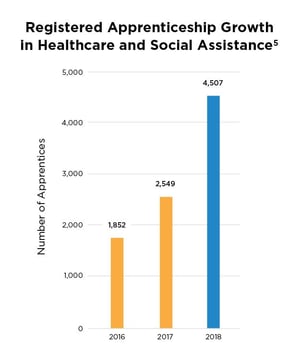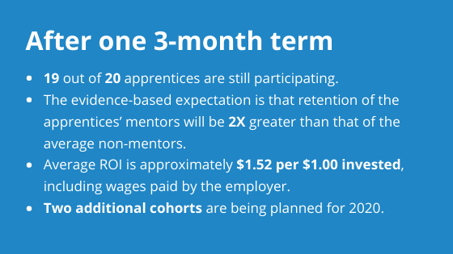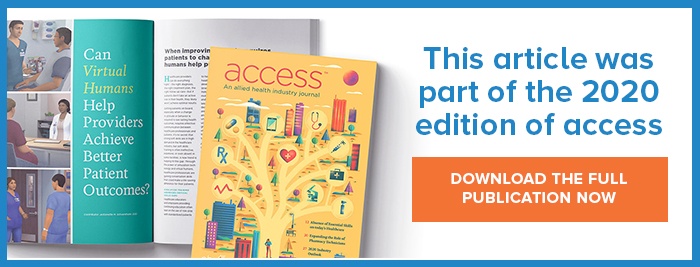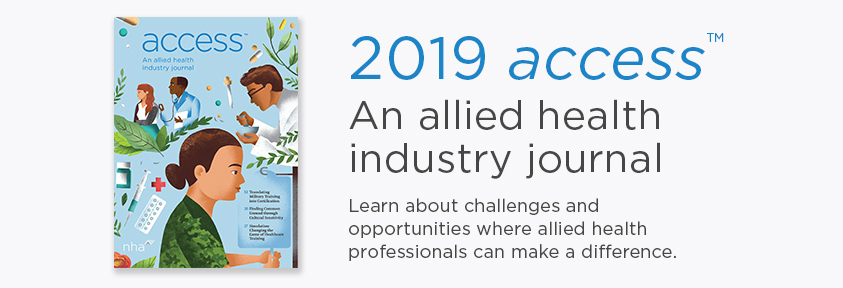Contributors: Mark Beaufait, Toya Moore, Betsy Conrad
The problem: There are not enough certified medical assistants in the labor market.

Every 11 seconds, an older adult is admitted to the emergency room for a fall. Approximately 80% of older adults have at least one chronic disease, and 77% have at least two. Additionally, one in four experiences some form of a mental health condition, including depression and anxiety disorders, and dementia—a number expected to double by 2030.1 As the United States’ aging population grows, increasing healthcare needs are creating more pressure on healthcare providers and their teams.
Support staff, and in particular medical assistants (MAs), are often the first people patients interact with during a medical appointment. Currently, there is far more demand for these critical team members than what exists in the workforce. The Bureau of Labor Statistics estimates a 23% growth in demand for medical assistants through 2028.2 Unfortunately, throughout the country, there aren’t enough skilled candidates to fill these roles. As demand increases, a persistent shortage of qualified healthcare workers will mean thousands of positions will remain unfilled if new solutions are not found.
 Is the apprenticeship model a viable solution to the healthcare hiring dilemma?
Is the apprenticeship model a viable solution to the healthcare hiring dilemma?
The healthcare labor issue isn’t due to a lack of interest in the profession. According to Mark Beaufait, director of apprenticeship at Healthcare Apprenticeship Consortium in Washington, there are barriers preventing interested individuals in obtaining the training and certification they need to start a medical assisting career.
“There are plenty of qualified individuals that are untrained. They are interested in living wage jobs but just don’t have the training ... and they aren’t necessarily able to get the training if they have to take a year or two off of work to go to school,” Beaufait says.
As adult learners, many of these candidates have financial obligations—such as living expenses and dependents/children to support—that prevent them from getting the education they need for the career they desire.”3
Registered apprenticeships help eliminate these barriers by providing an opportunity for students to “earn while they learn.” This model, historically used in manual labor fields like construction, combines paid on-the-job learning with classroom instruction and an industry-recognized credential (upon program completion) to help fill labor gaps with highly-qualified workers.
Healthcare organizations started utilizing registered apprenticeships in recent years to help address the demand challenges for skilled workers. In fact, the U.S. Department of Labor just began reporting on healthcare apprenticeships within the last five years. Since 2016, the number of healthcare apprentices has more than doubled, growing from 1,852 apprentices in the “healthcare and social assistance” industry to 4,507 in 2018.4
This growth can be attributed to the success of healthcare apprenticeship programs across the country and their effectiveness in solving the workforce gap. According to the U.S. Department of Labor, some benefits healthcare organizations adopting the registered apprenticeship model have experienced include:
- Improved productivity, cost-effectiveness and patient care.
- Flexible, customized training options.
- Standardized training so all workers receive the same national, industry-endorsed training at all facilities.
- Diversified workforce.
- Reduced turnover and liability costs.
- Tax credits and employee tuition benefits in participating states.6
Because many healthcare organizations struggle with retention, reduced turnover is one of the most attractive benefits of apprenticeship programs. Numerous studies conclude that retention is higher among apprentices because they develop a sense of loyalty to their employer. It’s especially true for healthcare, according to a report for the Skills Funding Agency conducted in the UK.6 Their report found that staff retention levels were highest in the Public Services & Healthcare sector when compared to apprenticeship programs in other industries.6 In fact, 85% of healthcare employers surveyed said their apprentices were still working for them, and an impressive 92% of employers in all sectors said that apprenticeships lead to a more motivated and satisfied workforce.7
Using the registered apprenticeship model, healthcare organizations that were once struggling to find candidates are now gaining a highly-skilled, diverse workforce that is driven and loyal. Although it takes some investment upfront in both time (training) and money (depending on the sponsorship/grant/funding obtained), the improved productivity and tax credits gained from registered apprenticeships can result in a positive ROI for employers.
 Case Study: How registered apprenticeships in the state of Washington are benefitting healthcare employers, educators, and aspiring medical assistants
Case Study: How registered apprenticeships in the state of Washington are benefitting healthcare employers, educators, and aspiring medical assistants
Sponsor: Healthcare Apprenticeship Consortium of Washington
Training Agent: Kaiser Permanente
RSI (Related Supplemental Instruction) Provider: Seattle Central College
2,000 hours on-the-job training, plus direct and indirect supervision by medical assistant mentors
288 classroom hours
NHA CCMA certification upon completion
A consortium in the state of Washington developed a registered apprenticeship to help fill the need for qualified MAs in the region. The consortium consists of multiple unions, healthcare employers, and retained education provider, Seattle Central College. Employers were struggling to fill the demand for qualified MAs, and Seattle Central College was experiencing a high volume of dropouts from its medical assisting program. This combination prompted action, and the registered apprenticeship was born.
For the first implementation of the program, employers carefully selected 20 MA apprentices to participate (out of 181 applicants).9 After the first quarter, 19 were still participating—an excellent initial indicator that most will successfully finish.3 “Usually there is a drop of at least 40% from the first quarter to the second quarter [in traditional MA programs] because a lot of times students come into the MA program not understanding how challenging the material actually is. To have 19 out of 20 moving on is great. We’re definitely going against the statistics moving forward,” says Toya Moore, medical assisting program director at Seattle Central College.7
Apprentices must perform 2,000 hours of on-the-job training, 288 classroom hours, and pass their national certification exam (CCMA) in order to complete the program.3 This will take approximately 14 months for most apprentices—12 months of classroom curriculum and approximately two additional months to finish the on-the-job training requirement.8
Compensation covers time spent with the employer and also the apprentices’ time spent in the classroom and lab (but not homework). To materially reduce barriers to completion, apprentices have access to resources from the consortium, a consortium hired support entity Connect for Success, Seattle Central College and employers like Kaiser Permanente. Support includes a navigator, gas cards, coaching/counseling, benefits and aid advisors.3

The program is funded by a variety of sources, including state-issued grants, local regional workforce development councils, philanthropic groups through the Healthcareer Advancement Program (HCAP) and the U.S. Department of Labor. This funding covers the cost of the apprentices’ tuition, as well as equipment (computers, textbooks, etc.).3
Each apprentice is matched one-to-one with an employer mentor. Mentors are existing MAs who have shown interest in a leadership opportunity and receive extra compensation for their mentoring hours. “The mentors are able to see themselves as teachers and leaders and are recommitting to the standard work of the organization as they take on this new mentor role,” says Betsy Conrad, the apprenticeship program manager at Kaiser Permanente. “It’s been going really well.”8
Three months in, the apprentices are running at roughly 40% productivity for the main competencies that an MA needs to have to practice, according to Healthcareer Fund’s Mark Beaufait. Although a traditional MA hire who has already achieved certification may be operating at 90-100% productivity within several weeks, the loyalty of not only the apprentice but the apprentice’s mentor helps contribute to a positive ROI, if a traditional MA hire is available.3

Retention for mentors who are actively engaged in the process is double that of non-mentors in the same occupation.3 “So, they [employers] gain in retaining mentors and they gain new medical assistants in roughly equal numbers,” notes Beaufait.
Having director supervision and a one-on-one mentor is not a requirement by the U.S. Department of Labor for a registered apprenticeship, but it is a healthcare quality-centered fundamental, and fits Washington’s registered apprenticeship requirements. The Washington Consortium believes this element of the program is one of the keys to their success.3
“Some of our apprentices have never attended a school outside of high school. Some of them did not even graduate from high school [but a GED is required]. So not only are they learning how to become an MA, they’re learning how to be a student. They’re learning how to be active in the workforce. So, there’s a lot of challenges that we have with the apprenticeship…beyond simply the MA curriculum. There’s a lot of growth in mentoring that goes along with it that I believe is a key part of the success,” says Moore.8
Due to the promising results, the Consortium is already working on two additional cohorts for next year. “The employers are enthusiastic,” exclaims Beaufait. “We have sufficient interest now to spin up two more cohorts next year. There may be more beyond that.”
The healthcare space has always valued hands-on learning. The earn-as-you-learn model of registered apprenticeships is a growing trend that is helping healthcare employers develop highly-skilled healthcare workers, such as MAs. Registered apprenticeship brings the full academic rigor of traditional programs to “earn while you learn.”
By combining on-the-job training with classroom curriculum and national certification, registered apprenticeships in healthcare are addressing the critical shortage, improving retention, creating greater efficiencies, diversifying the workforce and ultimately improving healthcare organizations’ bottom line. Scaling will take time, but the early results indicate investing in this model will have a long-term positive impact.
Beyond the statistics and ROI, these programs are making a life-changing difference for apprentices, who may not have access to an opportunity for a rewarding healthcare career otherwise. Moore says, “It empowers people to have a job that they’re proud to go to and to feel part of their community.”
1. National Counsel on Aging. July 2018. Healthy Aging: Fact Sheet. Retrieved on January 6, 2020 from https://www.ncoa.org/resources/fact-sheet-healthy-aging/.
2. Bureau of Labor Statistics, U.S. Department of Labor, Occupational Outlook Handbook, Medical Assistants. Retrieved on December 15, 2019 from https://www.bls.gov/ooh/healthcare/medical-assistants.htm.
3. Beaufait, M. (2019, December 18). Healthcare Apprenticeship Consortium, Washington. (C. McDonald, Interviewer)
4. U.S. Department of Labor, Apprenticeship Data and Statistics. Retrieved on December 10, 2019 from https://www.doleta.gov/oa/data_statistics.cfm.
5. U.S. Department of Labor. Apprenticeship Data and Statistics. Retrieved on January 27, 2020 from https://www.doleta.gov/oa/data_statistics.cfm.
6. U.S. Department of Labor. Healthcare Fact Sheet. Retrieved on January 4, 2020 from https://www.dol.gov/apprenticeship/industry/pdf/Healthcare-Fact-Sheet.pdf.
7. Centre for Economics and Business Research, “The Benefits of Apprenticeships to Businesses: A report for the Skills Funding Agency.” March 2015. https://www.cebr.com/wp-content/uploads/2015/03/The-Benefits-of-Apprenticeships-to-Businesses.pdf (Visited December 12, 2019)
8. Moore, T. (2019, December 4). Apprenticeship program at Seattle Colleges. (C. McDonald, Interviewer)
9. Nelson, J., Conrad, B., Paradise, C. (2019, December 20). Apprenticeship program at Kaiser Permanente. (C. McDonald, Interviewer).





